Text
I uploaded day 29 early on accident 😭 sorry lmao, guess I get a break tomorrow at least in exchange for a double feature.
1 note
·
View note
Note
May I ask for Dagda please?
Dagda - Day 29 (Request)
Race: Deity
Alignment: Neutral
April 29th, 2024
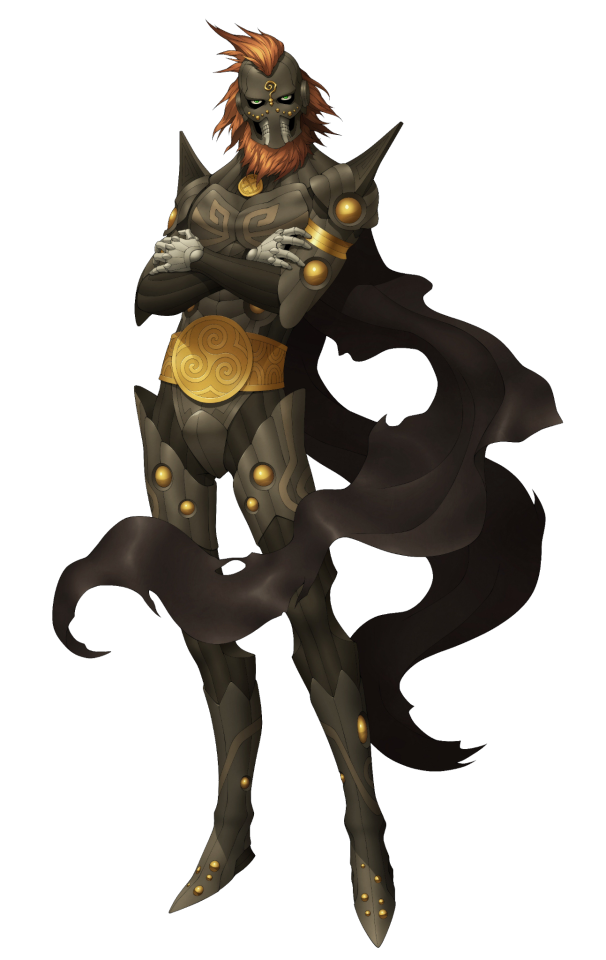
Ah, Celtic mythology. What would SMT do without you? Today's demon of the day, by request of @kitkatisacat, is the supreme leader of the Tuatha Dé Danann, the Dagda! With a special spotlight in SMT IV: Apocalypse, this druidic deity has many a myth attached to him, being one of the greatest heroes that Irish myth has.
The origins of Dagda are unclear, but the mythos purports that every one of the Tuatha Dé Danann, the mysterious and inherently mystical race that Dagda, among many others, belong to, originate and live within the mysterious 'Otherworld.' Descriptions of the otherworld are vague and varied, but are typically described as a "heavenly land beyond the sea, or under the earth's surface," as Celticist John Carey put it. This could basically mean any island far from Ireland, and this is when a major road bump presents itself: Much like Norse mythology, basically all primary sources on Irish mythology are heavily bastardized by Christian influence. The Tuatha Dé Danann could be gods, as commonly theorized, but are always portrayed as another race, one of witches, scholars, or fallen angels. This makes research frustrating, to say the least, as it's hard to distinguish between a genuine account and some Christian fanfiction tossed into the Celtic melting pot.
However, given that Tuatha Dé translates almost directly to "Tribe of the gods," we can make some extrapolations. Even the term Tuatha Dé Danann translates to "Folk of the goddess Danu," who likely is in the same boat as the norse "god above all other gods," given her lack of references in other texts- aka, another Christian retcon! Isn't mythology fun? Now, with that out of the way, Dagda originates as a deity who arrived at Ireland from overseas, and was one of the great leaders of the gods, seeming to be the head of the pantheon in a way. He possessed many mystical artifacts, including an always-full cauldron of porridge, fruit trees that were always ripe, two immortal pigs, and a massive club that could both kill and give life. His harp, another possession of his, played itself, and could bring about the seasons. All of this is to say, Dagda wasn't just a mystical man, but easily could be extrapolated into being the head god of sorts in the Irish pantheon, that was then retconned into just being mystical people from a far-off land.
The Dagda, though, had a sour attitude unbefitting of his heavenly role- most depictions of him are of a foul-mouthed man in a peasant's tunic, one who cares little for what others say, but ultimately is benevolent. Unfortunately, depictions of him are very scarce, as he was typically thought of as one of those gods, the omnipresent ones who embody everything under their domain. This does tie into what is a rather popular tale, though- the one about the war with the Fomorians.

I'll cover them more in-depth in their own spotlight later down the road, but the Fomorians were essentially demonic pirates from overseas who went to plunder and destroy for their own gain. Seeing their approach, the Tuatha Dé Danaan prepared for conflict, but Dagda struck out on his own. Having seized the land targeted years ago from the Fir Bolg, he was unwilling to concede, but also wanted to avoid needless violence and thus approached the Fomorians with a peace treaty. Predictably, they refuse, and challenge him to drink the endless cauldron of porridge he carries in order to get home safe. Likely thinking they had him, they only watch as the Dagda proceeds to bottoms-up the entire cauldron, dunking the entirety of the porridge down his throat and even licking the bottom to clean up any sticking scraps.
Baffled, the Fomorians gave up, let him go home, and prepared for battle. It would be during this battle, however, taking place a few days later, that unfortunately, the Dagda would lose his life at the hands of Caitlín, the wife of Balor, leader of the Fomorians. Unfortunately, a lot of this is frustratingly vague, holes upon holes of understanding left behind due to the fractured history surrounding Celtic myth. There are several retellings of several myths- in some of them, Dagda doesn't die, or he dies from his wounds, or even escapes into an underground palace. All of this goes to say, we can thank historical Christians for messing everything up.
Past all this, though, Dagda has a fantastic design taking heavy inspiration from what little we can glean about him, and his role in Apocalypse cannot go understated. All of this goes to say, while this was a difficult DDS, the Dagda's role in it is fascinating.
#shin megami tensei#smt#megaten#persona#daily#ask#request#I ACCIDENTALLY UPLOADED THIS ONE EARLY#FUCK ME#oh well ig tomorrow i get a break lmao
15 notes
·
View notes
Text
Chemtrail - Day 28
Race: Fiend
Alignment: Neutral
April 29th, 2024

Most demons throughout the SMT series are mythological beings, cryptids, historical figures, or just plain demons, but sometimes, they like to experiment. Sometimes, they make demons like the subject of today's Demon Spotlight, Chemtrail- a demon not based upon a historical account nor a religious belief, but rather, based on a conspiracy theory.
The idea of chemtrails originates in 1996, particularly from a report published by the US army regarding the idea of weather modification being used in warfare- as the conspiracy goes, the trails of condensation left behind by jets, known as contrails, are actually lines of chemical agents sprayed all over the public for nefarious purposes by the world elites. Many of these conspiracies blame these so-called chemtrails for things like diseases, mental illnesses, or many deaths around the globe, or even mind control by the elites to keep a populace subservient to their overlords.
Later in the 2000’s, the report was revealed to be a hoax, though many were left unconvinced by that turn, and chemtrails are still a widely held belief in conspiracy-laden circles of the United States. Many debunks have come out to explain what the trails in the sky truly are, that being trails of condensation left behind as water vapor in the jet's engine combines with the dry ambient temperature of the sky, though many remain unconvinced. The belief in chemtrails is surprisingly common, even to this day, though I suppose that is to be expected. You give someone in the bible belt a reason to hate the way the world is without blaming capitalism, and they'll snatch it up like a fish does bait.
Commentary aside, the conspiracy of chemtrails still retains relevance in pop culture, commonly cited as a ridiculous example of the conspiratorial beliefs of many people. However, while I personally doubt the existence of chemtrails, as do many others, the idea does have some credence to it- crimes like Agent Orange have given real weight and truth to the idea of world governments spraying chemicals down onto countries. However, given that this is a literal war crime, I'd hope that the US doesn't do that to their own citizens? But I wouldn't put it above them. Sorry to get a bit political, but it's somewhat unavoidable with this topic.
Segwaying back to SMT, though, I'm more surprised by the fact of the matter that this demon exists. It really just goes to show that, throughout the series, anything can be a demon- whether it be folklore, history, mythology, or anything in between, Chemtrail really feels like an example of both the experimentation that took place during IV, as well as being a testament to how widespread the moniker of demon truly is throughout the series. Anything can be a demon, as long as people believe in it, and that's oddly touching.
I don't know why it's a fiend, though. The idea of chemtrails being a skeleton brings up more questions than answers.
#shin megami tensei#smt#megaten#persona#daily#chemtrails#again#sorry to get political!#it's just.#very hard to avoid with this topic lmao#i tried to be as neutral as possible but i'm a lefty at heart so my bias probably shone through#tho given that this is tumblr#i doubt that'll bother much of anyone lmao
14 notes
·
View notes
Text
Pellaidh - Day 27
Race: Wilder
Alignment: Dark-Neutral
April 26th, 2024

Eugh, it reeks in here. Today's demon of the day is- ack, excuse me- Pellaidh, the- hold on. Gimme a sec.
Hey, stay still! You know my asthma can't take this!
Ow!
Get in there already!

Okay. That's better. Way better. Alright, with that out of the way, today's demon of the day is the shaggy Scottish swamp sprite, Pellaidh! In spite of how common this demon tends to be throughout the series, the source of the Scottish Fuath in question is comparatively obscure, seeming to only appear in scant studies about celtic folklore.
The origin of the Pellaidh seems to come from it being a subspecies of the Scottish Fuath, a race of spirits who are typically malevolent, if not outright violent, and who typically attack people who pass by the rivers they typically dwell in. The most common and easy to understand example of a Fuath comes in the form of the Banshee, who will get her own spotlight eventually, but the overall umbrella term of fuath coincides with tricksters and troublemakers in Celtic lore, most of whom dwell in rivers, creeks, and lakes. A pellaidh is one of those spirits, a monster who haunts the waters, though it has one very specific place that it calls home.
Pellaidh's name comes from where it houses itself, as it was a variant of an ùruisg with long, stringy, and shaggy hair that lived near the town of Aberfeldy, or as it was referred to back then, Aberpheallaidh. An ùruisg was essentially a far less friendly version of a brownie, which will also get their own spotlight eventually, but were essentially fairies who lived in houses and helped with chores. In the Pellaidh's case, they were a Scottish variant of the brownie who instead reside in rivers and are far less friendly. While ùruisg, and, by extent, pellaidh were violent, tempermental, and cruel, they could be domesticated, and once that was done, they became fiercly loyal and, soon, the best friend one could hope for.
As a regional variant of an already obscure fairy, Pellaidh was hard to research, as there's barely anything concrete to go off of. However, in spite of this lack of information, the design team behind this shaggy sprite made a design equal parts intimidating as it is iconic. Its horrible smell likely originates from how it lives under the polluted waters of Tokyo in IV, and its rivalry with its fellow Scottish water dweller Kelpie makes for a memorable boss encounter early in the game. Overall, while Pellaidh isn't my favorite demon, its unique design and early boss fight in IV makes it stand out in my mind.
Sources! I gotta start citing these more.
https://pantheon.org/articles/p/peallaidh.html
https://pantheon.org/articles/u/uruisg.html
https://www.quora.com/What-is-the-story-behind-the-Scottish-fairies-Urisk-and-Peallaidh
I know this is mostly just for fun, but it's still common courtesy. Thanks for reading!
6 notes
·
View notes
Text
David - Day 26
Race: Fiend
Alignment: Neutral
April 25th, 2024

The Danse Macabre is one of the most famous pieces of classical music- a winding tale of death and a beautiful dance unto one's own end, with its own folklore surrounding it. On All Hallow's Eve, one is said to be able to spot skeletons rise from their graves and play the song of death, dancing until the sun rises, whereupon they collapse yet again. One of the subjects of this dance, David, belies himself as the demon of the day- a fiend who dances until sunrise, and then some, when the moon is highest on Halloween night.
According to the poem that inspired the famous classical piece, Danse Macabre, when it turns to midnight on Halloween, Death will rise. However, he's not interested in claiming souls- instead, he shall play the fiddle, calling forth the dead from their graves to dance for him, causing a night of an ecstatic dance until the cockerel crows the day anew. It's then that the skeletons shall return to their graves, waiting for the next year to come.
This famous French legend is what the Danse Macabre is primarily based upon, and is also where David originates; in this case, David represents Death in the story, calling upon his fellow fiends to dance a dance of death that continues until dawn. Heeded with the playing of his violin, he guides the living to the realm of the dead to play and dance alongside the legions of the revived skeletons. David is a unique invention, though, and his name seems to be based on the instrument he plays, that being the Davidoff Stradivarius violin.
David's design is clearly inspired by classical depictions of bards, as is his ability described in the compendium- according to most descriptions of him throughout the series, he plays songs on his enchanted violin that drive people to madness, dancing unto their death. This may be a bit of a reach on my part, but I personally hypothesize that this may also be inspired by the infamous case of mass hysteria, the Dancing Plague of 1518. Maybe, in the SMT world, David was the one who caused so many people to dance to their literal deaths in such a frenzied fervor. Another possible connection lies in the famous tale of the Pied Piper, what with his ability to control people through dance, though this is admittedly also a bit of a stretch.
David is typically one of the first fiends faced in the series, owing to his non-intimidating appearance and the fact that the most he does is play the fiddle, and he mostly serves as a useful early-game debuffer and magic attacker. He's a nice introduction to the fiend race, serving as a quick and easy guide to a game over, though nothing too special.
However, in spite of his lack of backstory and middling stats, David has certainly won my heart with his fun design and mix of inspirations, and I hope that we can all spot him next Halloween night playing the dance of death for years to come.
#shin megami tensei#smt#megaten#persona#daily#david#the skeleton appears#this little FREAK caused the dancing plague you will NOT change my mind its CANON TO ME.#anyway this was a fun one!#i always will love the fiends
10 notes
·
View notes
Text
Barong - Day 25
Race: Avatar
Alignment: Light-Neutral
April 24th, 2024

I'd like to start this daily demon spotlight with an admittance of bias. Barong is my favorite demon in the series, bar none. In celebration of making it to 25 (!!) days of this series, I've decided to let the holy cat out of the bag. Barong is the demon that introduced me to Balinese mythology, has saved my hide several times throughout the series, and has an adorable and unique design to boot. He stands right next to, if not above Black Frost and Chernobog in my book. Past that, though, I would also like to say- thank you all for sticking with me for 25 days! It's been so damn fun, and I plan on continuing this series for months, if not years to come. I know it's a little early for the ivories, but the small community that has been built up over time has given me so much life and energy!
With that sappy stuff out of the way...
Today's demon of the day lies in the form of the great panther, protector of mankind, and host of all things good, Barong. Bali mythology is surprisingly easy to look through, having solid roots and foundations, as well as its origin being in a somewhat small subset of Indonesia, though this isn't to say it's not complex. Balinese mythology takes a unique form, one similar to the worship of Ame-no-Uzume, wherein several of its stories aren't plays nor grand tales, but rather, fascinatingly hypnotic dances. Barong's appearance in these dances is that of a glamorously decorated (and very ambiguous) animal that I would personally say looks somewhat, vaguely similar to a lion?

However, the type of animal it is isn't that important, and admittedly just makes me confused. What is important is Barong's role in Balinese mythology, that being of a protector of humanity itself- in the mythos surrounding Barong and its eternal rival Rangda, Barong represents good health, good fortune, and has reign over all the spirits that inhabit the small province. The most prominent myth featuring the great avatar is recanted in the famous Kris dance, a dance representing Barong battling with Rangda. During the hypnotic trawl, dancers bring swords dangerously close to hurting themselves, though they emerge unscathed, watched over by two dancers in an ornate harness holding up the avatar of Barong who dances furiously behind them.
The dance begins with two monkeys and Barong engaging in dance, though quickly escalates as witches sent by Rangda attack the frolicking group. The dance-drama escalates from there as Barong tries to reign back control over the kingdom, which had found itself under siege by Rangda, eventually leading to the most iconic scene of the play, wherein two palace guards stab themselves with kali daggers in a desperate trance under Rangda's control- though they emerge unscathed as Barong comes to the rescue and engages in battle with the witch, protecting the guards with his holy magic. After a long and fraught dance between Barong and its rival, eventually, the holy avatar emerges victorious, and the kingdom is returned to peace and prosperity.
Barong is not just an artefact of the dance, though- he's an important figure in Balinese tradition, one held in reverence and good spirits, and the dance is simply held to represent the eternal struggle between good and evil, as well as celebrate the triumph of the love and goodness that Barong represents. People equipped in Barong costumes even, on occasion, parade around Balinese towns in order to ward off evil spirits and bad luck. Barong is locked in a never-ending battle against Rangda and the forces of darkness, yet never gives up hope; As a Bali volunteer in the Bali Volunteer Program puts it, "Once the trance is over, Barong and his supporters finally overthrow Rangda. But she does not die. Instead, she reincarnates and Barong must defeat her again. The fight never stops. It is symbolic of light’s eternal strife against darkness."
In the SMT series, Barong is depicted faithfully, though far more blue than red. Decorated in jewels and studded in silver, the Balinese lion dances in combat, easily connecting to the dance-dramas the beast is so frequently depicted in. Interestingly, a common series staple is that of Rangda and Barong's fusion leading to Shiva, and while unconfirmed, I have an idea as to why this may be the case. While Barong and Rangda are from completely different mythologies, they both represent opposing forces of light and dark, something that Shiva, a god of destruction who is not evil, is an inherent blend of- Shiva is both light and dark, good and evil, while Barong is good, light, and Rangda is evil, dark.
All in all, Balinese myth's hypnotic dances and beautiful performances lend to an amazingly designed demon that truly fulfills all it sets out to do, represents an underrepresented mythology, and stands out as my personal favorite demon in the series. Next to Chernobog and Black Frost, of course. And also Parvati. And Mother Harlot. Am I just edgy?
#shin megami tensei#smt#megaten#persona#daily#smt nocturne#barong#bali#baliindonesia#balinese#hehe funny doggy..#the dances that i talk about in this dds are really fascinating to look at#i didn't put any pictures of the dances themselves due to how most depictions are#very similar in appearance to self harm?#but if you can stomach it they are fascinating#self harm mention#tw sh related
11 notes
·
View notes
Text
Day 24 - Idun (Request)
Race: Megami
Alignment: Light-Neutral
April 23rd, 2024
accidentally spoiled this one, oops.
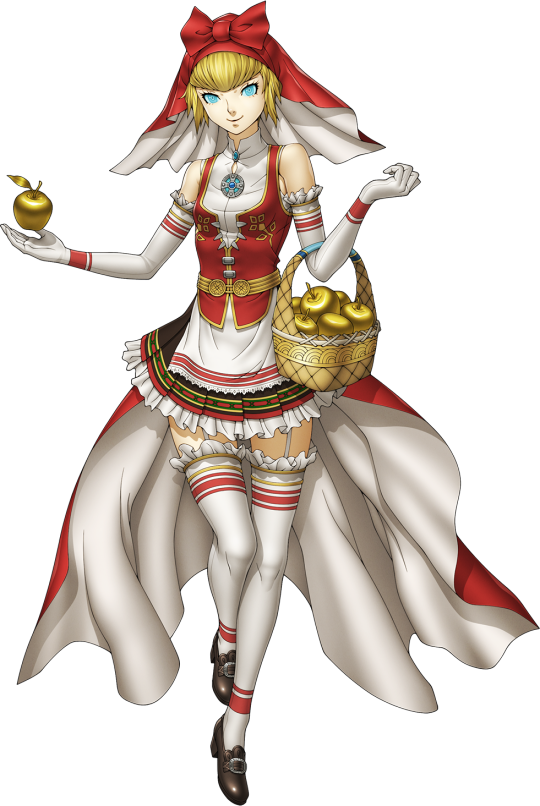
Norse mythology, as any amateur theologian would likely know, is a bizarre beast to look into- a winding complex of bastardized tales and Christian retcons that makes even some of its most iconic gods appear scantly and obscurely in its stories. However, our demon of the day is one of the most recurring goddesses in the entire pantheon- the goddess of apples and youth, Idun.
Well, maybe that's a bit of an overstatement, but a Norse god appearing in more stories than one in the Prose Edda is an accomplishment in-and-of-itself. Idun, also known as Idunn, Iduna, or Iðunn, is the ancient Norse deity who resides over apples, spring, youth, and rejuvenation- she was likely well worshipped in her place, representing such pleasant thoughts (outside of spring due to the scourge of pollen, but let's not get into that) and ideas. Her name even seems to be based upon ideas of kindness and healthiness, as it's based upon the old Norse words ið, meaning "again," and unna, meaning "to love."
All of this, alongside her association with one of the best fruits (objectively), apples, seems to paint her in the light of being a goddess that the common people looked up to and worshipped for a nice, peaceful life. Idun is also the wife of Bragi, the god of poetry, something that adds on to this lovingly creative persona- she seemed to have been a lesser goddess, yet one still revered and loved for her role in cultivating a beautiful year with fantastic food. Even today, in some pagan circles, she is still worshipped, as she was in the past as well, a goddess representing good spring and fortune.
Idun's most famous myth comes about with those same apples she treasures so dearly- they weren't any old apples, you see, as the ones she specifically grew were apples of immortality. These apples were relied upon by the pantheon to remain young and spritely (likely leading to her title as the goddess of youth given her role in cultivating those apples) and she protected the orchard where they were grown diligently. However, a jötunn by the name of Þjazi forced Loki's hand, getting him to drag Idun away from her orchard only to kidnap her. As a consequence of her absence, the gods soon began to grow old and frail, and finding nobody else responsible, they found the blame to be on the trickster god present.
The gods weren't mad with him specifically, though- they knew that Loki wasn't that petty and mean to steal the immortal apples without reason. As a result, in an effort to make him right his wrongs, they sent him out to retrieve Idun from the claws of the jötunn, Loki adopting the form of a falcon and chasing after the giant in great pursuit. After a while of searching, he found the (likely terrified, or maybe even annoyed) Idun, who turned into a single small nut to let him escape with her untouched. Shortly after Loki makes his daring escape, the giant comes back to find his captive goddess gone with the wind, and chases after Loki in hot pursuit in the form of a massive eagle. However, the gods devised a plan to stop this rampaging jötunn, causing the eagle to run right into a then-lit pyre and setting him ablaze. With Idun returned to them, they went back to eating from the immortal apple stock, and all lived happily ever after. Until Ragnarok stuff happens, but let's not worry about that!
While Idun does fill a role as an archetypal 'damsel in distress,' her main story does show how important she actually is to the Norse pantheon; without her, they wouldn't be able to live. As a result, while a minor deity, she has a major role in the pantheon- one that is reflected perfectly in her role in SMT V.
In SMT V, Idun's only current appearance, she appears as a late-game healer and support demon with a whole sidequest attached- one that I can't recant here due to not playing V, but it seems fun. Design-wise, she bears a striking resemblance to Little Red Riding Hood (as well as Aigis for some reason), something which feels obvious given her role as the owner of the divine orchard with a wicker basket holding her magical apples, drawing clear parallels with the apples that Red Riding Hood delivers to her grandma.
She also tends to hit the griddy.
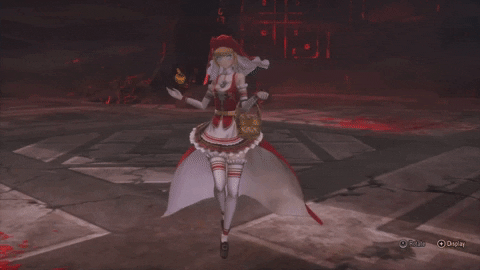
Why? Because it's cute!
Overall, this charmingly designed demon from one of the most famous mythologies out there gets an A in my book. The influence behind her design is clear, it's cute and effective, and it works given her folkloric prescedent.
17 notes
·
View notes
Text
Day 23 - Halphas
Race: Fallen
Alignment: Neutral-Chaos
April 22nd, 2024
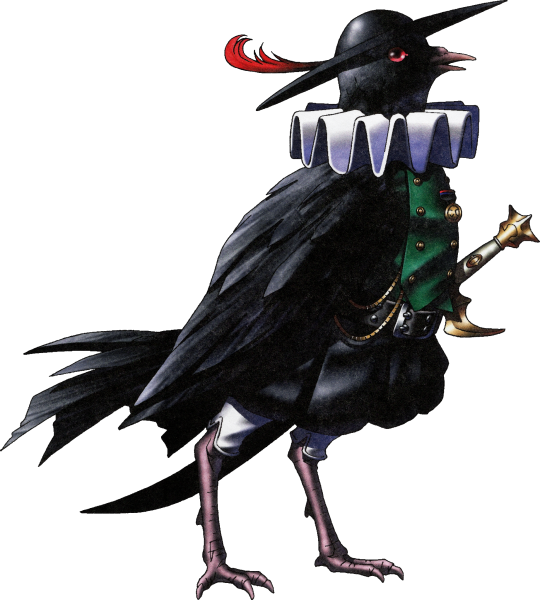
The Lesser Key of Solomon is a common source for demons throughout the SMT series, and for good reason- our favorite Goetic grimoire remains as the biggest still remaining demonic compendium out there, having 72 Marquis of hell to summon to assist in one's daily life. The demons of the Ars Goetia are varied and strange, but one sticks out as a personal favorite of mine- the regal Stock Dove, Halphas.
Listed as the 38th demon within the Ars Goetia, Halphas, also known as Malthus, is known as a "Great Earl," referred to as follows.
"The Thirty-eighth Spirit is Halphas, or Malthus (or Malthas). He is a Great Earl, and appeareth in the form of a Stock-Dove."
While, as with many goetic demons, the description of Halphas is vague, his reign seems to paint a picture of him being well versed in battle and blades, as his domain resides over the stocking of weaponry and sending people out to battle, almost like a tactician. He can also apparently build up towers, likely alluding to an ability to erect massive buildings from the ground in only an instant, owing to his immense demonic power- as a duke of hell, after all, his strength is nigh-unmatched. With a rule over 26 legions of spirits strong, the demonic warlord this bird turns out to be stands in quite interesting contrast to the typical representation of peace that a dove represents.
Design wise, the feathered cap and ruffled frills around the neck paint the image of this bird being some sort of great rich royalty, something supported by its reign as a Great Earl, and the gold blade he wields also gives way to the idea that this bird is a marquis of warfare. Overall a fantastic design filled with unique symbolism, and a personal favorite of mine.
#shin megami tensei#smt#megaten#persona#daily#halphas#malthus#malthas#the ars goetia#sorry for the short analysis! i've lost a bit of my steam lately#and the ars goetia demons dont have a lot to go into on their own.#i'll be back to regular soon tho!
10 notes
·
View notes
Text
Accidentally uploaded Day 24, which was a request, while in the drafts and very, very early in creation. Oops.
2 notes
·
View notes
Text
Mizuchi - Day 22
Race: Snake
Alignment: Neutral
April 19th, 2024
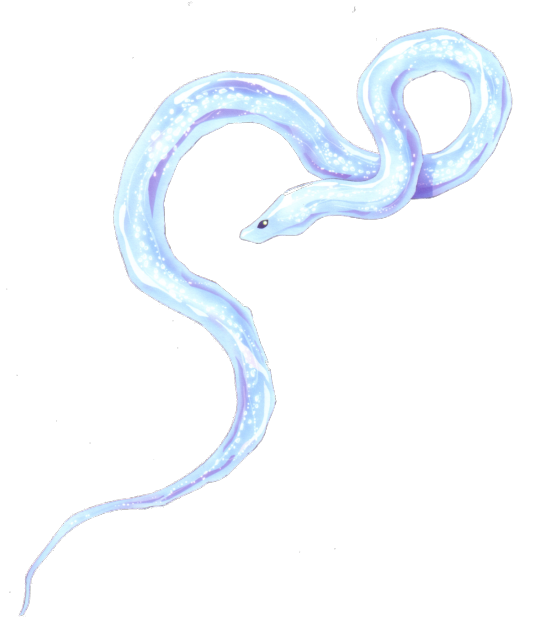
Serpentine monsters are a common sight in mythology; whether it be the great Dragons of yore, the feathered serpent Quetzalcoatl, the aboriginal Rainbow Serpent Yurlungur, or even the classical Ouroboros. However, Japan loves snakes in mythology. We've already covered one in Yamata-No-Orochi, but there are so many more, whether it be the adorable and hilarious Yokai Tsuchinoko, or, in the case of the demon we're covering today, the legendary water serpent, Mizuchi.
Mizuchi is rarely seen throughout the tremendous amounts of tales that make up Japanese mythology, only mentioned in the Nihon Shoki (the oldest still-remaining text of Japan's history, dating all the way back to the Yōrō era) as well as appearing in a single Man'yōshū poem. In spite of this, Mizuchi has been the topic of many scholarly debates, eventually being bastardized through history into everyone's favorite root-chakra destroying turtle, the Kappa.
Mizuchi, however, is not originally from Japan- its name is actually a transliteration from several Chinese glyphs, particularly several glyphs describing different dragons, serpents, and monsters of Chinese mythology. Admittedly, I don't know much about Japanese, but one of the kanji used to spell the name Mizuchi implies that it's a snake, but it first-and-foremost means "Water spirit." The word, in English, can be broken down into "Spirit-of-Water," as Mi- means water, -tsu- (the way that it is pronounced) effectively means 'of,' and -chi is a suffix that describes a spirit. Due to this, Mizuchi's origin as a Chinese myth makes it very, very hard to track down much of a solid origin for it, given that it originates from what was effectively a way to match how it sounds to how it's spelled.
Now, in terms of mythology, Mizuchi was first referenced in the Nihon Shoki- as the story goes, under the reign of Emperor Nintoku, there was a fork at a river that contained a great water serpent that would be a very deadly nuisance- it attacked random passersby, spat venom at anybody who came near, broke apart caravans, and was generally just a prick. Eventually, fed up with this, a man named Agatamori approached the spirit with a challenge- he tossed three Calabashes into the water and challenged the spirit to see if it could sink them. If not? Mizuchi would face a swift death. The dragon, perturbed, obliged, yet was unsuccessful, meeting a demise by the hands of the man.
Later on, Agatamori found his way to the fellows of the mischievous snake, and in a move as genocidal as it was unwarranted, slaughtered the entire clan of Mizuchi. The lake below was filled with their blood, later becoming the noted "Pool of Agatamori." However, in spite of how apocalyptic this may seem, it turns out that there are more recollections of Mizuchi in the mix, and this tale was but one of many.
The god of the river recorded in Nintoku 11 is also commonly seen as a Mizuchi. A dam being built along Yodo River was subject to an attack from an unknown force, completely breached. Confused, the Emperor commanded a rebuild of it, only for it to be breached yet again. This happened time and time again, and eventually, the Emperor saw a solution to his problem through a prophetic dream. Bringing two men to the riverfront, he offered them up to the River God, but one refused. Likely recognizing the circumstances, the man demanded to see the divinity of the snake by trying the age-old calabash trick, tossing a set into the river and daring the god to sink them. Unsurprisingly, the Mizuchi failed, and likely grew to resent calabashes for the rest of its life.
The last example of a Mizuchi in classical Japanese mythology comes from the Man'yōshū, a collection of ancient poems that have been passed down from generation to generation. In one of them, a poem composed by Prince Sakaibe, he describes a short and intriguing tale regarding a Mizuchi. In quote, "I could ride a tiger to leap over the Old Shack, to the green pool, to take down the mizuchi dragon there, if only I had a sword capable of doing just that." The story regards a mizuchi dragon as being almost common knowledge, bringing up as many questions as it does answers- however, the way it regards it in such a casual manner may play into why Mizuchi are so scarcely mentioned.
If everyone knew about mizuchi, then they wouldn't feel the need to record it, right? The casual cadence of the poem seems to give light to the idea that mizuchi were a common sight or concept in ancient Japan, and it may have to do with their later bastardization into Kappa. In some areas, kappa are given a name incredibly similar to a mizuchi, such as "Mizushi," "Medochi," or "Mintsuchi." Past this, a common trait in Kappa stories lies in their hatred of calabashes, something which is similar to the distaste Mizuchi have for calabashes in both stories they appear in. Some historians speculate that mizuchi and kappa were in the same general 'clique' of water dwelling monsters.
God, that was a lot. Mizuchi are confusing. However, in terms of the SMT series, there's a lot less to comment on; their appearance as a water spirit in the form of a snake is faithful, and their design is as simple as it is elegant. They appear to be made of clear water, almost like a rushing river in the form of a snake. Throughout the series, Mizuchi are a common sight in the early-mid game, even appearing as a boss in Nocturne. Their specialty in ice skills, the closest thing SMT has to water skills, is almost obvious. However, overall, there's elegance in simplicity, and Mizuchi is just that.
#shin megami tensei#smt#megaten#persona#daily#mizuchi#this thing was a HEADACHE.#probably the hardest demon so far to research#a lot of my stuff was taken directly from wikipedia#albeit reworded#and i feel a bit bad about it#but i can't read japanese!!#and almost all the primary and secondary sources are#lo and behold#in japanese.#however i do appreciate the challenge and i love looking into weird and obscure folklore!!#its just that this guy was way too much of a doozy.#never again. jesus h jimminy cricket.
8 notes
·
View notes
Text
Decarabia - Day 21
Race: Fallen
Alignment: Neutral-Chaos
April 18th, 2024

The greatest demonic compendium, the Ars Goetia, holds many strange demons, but one sticks out to many as the most peculiar; the sentient pentagram, and our demon of the day, Decarabia. An iconic design in the series, this demonic starfish has appeared in many SMT games, almost always as a fallen race demon, yet his role in the goetic grimoire is... bizarre, to say the least.
Decarabia is the 69th (nice? sorry, i just had to.) demon listed in the grimoire, and his description gives way to him being incredibly bizarre. Described as a pentagram star when first summoned, this Marquis of Hell's purpose is effectively as a treasurer and jeweler, providing his summoner with the ability to understand the value of any gems and gold in their possession when presented to the demon. As the lesser key of Solomon puts it,
"He appeareth in the Form of a Star in a Pentacle, ⭐, at first, but after, at the command of the Exorcist, he putteth on the image of a man. His office is to discover the Virtues of Birds and Precious Stones."
But what's that about birds? Well, I have no idea! Next to his ability to appraise gold, Decarabia provides his summoner with the ability to commune with birds, as well as being able to conjure a bird familiar to do one's bidding. Decarabia is strange, even by the standards of the grimoire, with his reign being defined mostly by a control over things that could either be done by a human, or are mostly useless!
However, I do have to admit, I respect the hustle. As the sixty-ninth demon in the grimoire, it's quite clear that Solomon was likely running out of good demons to summon, given that it finishes at 72 (Joke shamefully stolen from Tony4You.) Decarabia's entire existence is bizarre to me, yet also fascinating, a Marquis of Hell whose entire domain is based around things that most people could already do, or would have next-to-no interest in.
In SMT, though, this misfet marquis is given some much needed love- his design, a demonic starfish with an eye in the center, is about as good a design they could get given how vague most descriptions in the Ars Goetia are, and is iconic in its own right- you show even a casual Persona fan this star pentacle and they'll recognize him right away. Of note, of course, is his appearance in SMT III, wherein he's found in the city of Ginza waiting for the arrival of his best bud Forneus, who you murdered earlier that week. I gotta wonder if he ever found out about the untimely fate of his friend.
Overall, in spite of his domain being small and nigh-useless, this misfit starfish has won many an SMT fan's heart, and I'm no different. Decarabia my beloved.
#really interesting thought!#it could be plausible given that the ars goetia was written far after ancient rome's time#wish i could ask king solomon what he *actually* does#still#thanks for the addition!
21 notes
·
View notes
Text
Decarabia - Day 21
Race: Fallen
Alignment: Neutral-Chaos
April 18th, 2024

The greatest demonic compendium, the Ars Goetia, holds many strange demons, but one sticks out to many as the most peculiar; the sentient pentagram, and our demon of the day, Decarabia. An iconic design in the series, this demonic starfish has appeared in many SMT games, almost always as a fallen race demon, yet his role in the goetic grimoire is... bizarre, to say the least.
Decarabia is the 69th (nice? sorry, i just had to.) demon listed in the grimoire, and his description gives way to him being incredibly bizarre. Described as a pentagram star when first summoned, this Marquis of Hell's purpose is effectively as a treasurer and jeweler, providing his summoner with the ability to understand the value of any gems and gold in their possession when presented to the demon. As the lesser key of Solomon puts it,
"He appeareth in the Form of a Star in a Pentacle, ⭐, at first, but after, at the command of the Exorcist, he putteth on the image of a man. His office is to discover the Virtues of Birds and Precious Stones."
But what's that about birds? Well, I have no idea! Next to his ability to appraise gold, Decarabia provides his summoner with the ability to commune with birds, as well as being able to conjure a bird familiar to do one's bidding. Decarabia is strange, even by the standards of the grimoire, with his reign being defined mostly by a control over things that could either be done by a human, or are mostly useless!
However, I do have to admit, I respect the hustle. As the sixty-ninth demon in the grimoire, it's quite clear that Solomon was likely running out of good demons to summon, given that it finishes at 72 (Joke shamefully stolen from Tony4You.) Decarabia's entire existence is bizarre to me, yet also fascinating, a Marquis of Hell whose entire domain is based around things that most people could already do, or would have next-to-no interest in.
In SMT, though, this misfet marquis is given some much needed love- his design, a demonic starfish with an eye in the center, is about as good a design they could get given how vague most descriptions in the Ars Goetia are, and is iconic in its own right- you show even a casual Persona fan this star pentacle and they'll recognize him right away. Of note, of course, is his appearance in SMT III, wherein he's found in the city of Ginza waiting for the arrival of his best bud Forneus, who you murdered earlier that week. I gotta wonder if he ever found out about the untimely fate of his friend.
Overall, in spite of his domain being small and nigh-useless, this misfit starfish has won many an SMT fan's heart, and I'm no different. Decarabia my beloved.
#shin megami tensei#megaten#smt#persona#daily#decarabia#ars goetia#the tony4you influence is really rubbing off lmao#the goetia is insane to read through but decarabia was short and sweet#still#couldn't his job had been done by like.#any gem appraiser??
21 notes
·
View notes
Text
Day 20 - Agathion
Race: Yoma
Alignment: Neutral-Law
April 17th, 2024

Talismans and trinkets have always been the number one spot for mischievous spirits to hide away, but sometimes, the opposite is true; a demon doesn't possess one, but rather, becomes one. Enter an Agathion, a demon that has appeared throughout the series for many a game in spite of its lack of significance.
As the series itself puts it, there is no real consensus for the real shape of an Agathion, though the series depicts it as a small specter within a golden, occultly decorated pot. Agathion are effectively a version of the concept of a familiar, an idea originating in medieval European folklore- a spiritual being conjured by a witch or wizard who would fight alongside, assist, or just be a pet to its summoner.
Familiars had no real defined form, instead typically taking the form of a common household pet such as a cat, though they could really fit any shape. The main defining feature of a familiar, as opposed to a ghost, would be that it had a real, strictly defined form- a familiar would appear like any normal animal, yet had boundless magic, and could assist its summoner in any way they'd need.
Agathion are a specific type of familiar defined as being able to take the form of an inanimate object as well- a ring, a talisman, a bottle, whatever- though they could also do the classic familiar trick of appearing as an animal or even a human as well. The biggest defining trait of an Agathion lies in the time of day it grows strongest- while most familiars had a regular amount of power no matter the hour, an Agathion could be seen as running on sunlight, as their strength grows the most when it reaches midday.
There are, frustratingly, very few descriptions nor depictions of this demon out there, being a generally accepted idea without a concrete origin. I can't even find a historical depiction of a famous agathion- most of them seem to have been common folk belief in the middle ages, and what makes this even worse is that Agathion are also a thing in, what else, but Pathfinder, where their lore is completely different! My wild goose chase for any proof of an Agathion even existing in history has turned up squat, and I'm sorry for that.
The only definition I could find would be in the book "Encyclopedia of Demons in World Religions and Cultures" by Theresa Bane, which is a short, very apt description. I come to this blog bearing not much beyond a short description and a recanting of my frustration, and I'm sorry for that.
However, given how little there is to work with, Agathion's design in SMT is iconic for good reason- a perfect, mischievous depiction of the familiar that is as charming as one would expect. As such, while my research was frustrating and slightly soured my opinion on this demon, he's utterly adorable, so whatever.
#shin megami tensei#smt#megaten#persona#daily#smt nocturne#agathion#this was a pain in the neck to research lmao
7 notes
·
View notes
Text
Forneus - Day 19

Race: Fallen
Alignment: Neutral-Chaos
April 16th, 2024
Unsurprisingly for a series focused around demons, the Ars Goetia is a great point of reference for several demons in the series. The text, essentially a handbook for summoning demons, contains up to 72 kings of hell to bring about to the world to assist you, do your bidding, or just to fuck around with. Among these demons, particularly the 30th, Forneus, Marquis of Hell, makes himself known- a great sea beast.
Unfortunately, the Goetian grimoire wherein Forneus originates is very, very hard to read for my proclivities, but I'll try my best to transcribe it. Described in the text as a great sea monster of unknown proportions, Forneus helps to make those who summon him become well-versed in rhetoric, particularly to gain social status- as the book goes, "He teacheth, and maketh men wonderfully knowing in the Art of Rhetoric. He causeth men to have a Good Name, and to have the knowledge and understanding of Tongues."
Effectively what this means is that Forneus can be one's teacher in debate, and will help people to obtain social power through obtaining a good standard when it comes to speaking with others. Also promised is the delivery of the ability to speak in any tongue, provided one is able to even understand it, and an ability to mend rifts in one's relationship with another as well. "He maketh one to be beloved of his Foes as well as his Friends," the book proclaims.
While hastily described, Forneus's depiction as a beast of the ocean fits well with his design within SMT, being that of a manta ray with a human body on its back, hands long and outstretched, giving him a far more eerie appearance than what would normally be let on. The peak of the human head poking out from the stingray's back gives its top half an uncanny, human-esque appearance, and the crown dictates his stance as one of the dukes of hell.
The Ars Goetia is a strange text to read through, one filled with sigils and proclamations of real abilities to summon demons to the world, and it's one I've found myself utterly entranced with, mayhaps like a demon's spell in-and-of-itself. Overall, though, like most goetic monsters in the Megaten series, Forneus's depiction is incredibly faithful and unique, making his mark as a fan favorite demon that I find myself loving as well.
14 notes
·
View notes
Note
addon for the tags cus i needed to post proof

Hello! Is there any chance you could do Nahanananggal? One of my favorite designs in the series :3
Day 18 - Manananggal (Request)
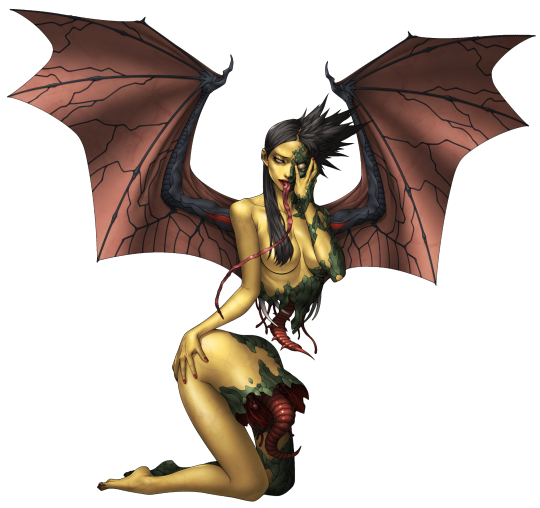
Race: Femme
Alignment: Neutral-Chaos
April 15th, 2024
Admittedly, I had no idea what I was getting into with this design. Having never played V, the game in which she first appears, I wasn't expecting to find much from a demon this late in the series, yet the Filipino influence in V gave birth to a strange, freaky, and frankly sick looking demon.
A witch from the Philippines, Manananggal is a strange, almost vampire adjacent bit of mythology typically used as a boogeyman of sorts. The strange folklore surrounding this being goes that it's a witch who takes the form of a beautiful young woman at day, yet shifts into a hideous form at night, typically infiltrating homes and villages to feed when the sun goes down on clueless families. Her name means remover, and that is exactly what she does, as the witch will typically target families expecting a baby and, when the sun goes down, will suck the blood of the fetus with a long proboscis, typically killing it.
My personal theory about this is that Manananggal may be a sort of explanation for stillbirths, as the idea of killing a baby while still in the womb coincides heavily with a stillbirth, as well as an early pregnancy, as some myths say that the witch may deliver the fetus far earlier than expected as well.
Typically in Filipino folklore, when it turns to night, the Manananggal will separate its torso from its chest, sprout wings, and the way to kill one is also connected to this hideous transformation.

At the left-behind torso of the witch, in order to kill a Manananggal, one must spread cloves of garlic or salt all over it. When the witch is to return when the sun rises, this will apparently remove the spell, causing the monster to burn alive in the sunlight, and be unable to rejoin with its body.
In terms of design, Manananggal is very faithful, appearing with a separated body from her torso in the sheen of a beautiful woman. The batlike wings and proboscis-esque tongue are very common in depictions of this monster, and overall, she has a very unique yet faithful design. Unfortunately, I cannot give a gameplay overview on account of not having played V yet, but this demon is shockingly well designed, and connected to a very underrepresented bit of mythology in the SMT series. 10/10 for me.
Now, I have to wonder, would a Manananggal find a lucrative business in abortion?
13 notes
·
View notes
Note
Hello! Is there any chance you could do Nahanananggal? One of my favorite designs in the series :3
Day 18 - Manananggal (Request)

Race: Femme
Alignment: Neutral-Chaos
April 15th, 2024
Admittedly, I had no idea what I was getting into with this design. Having never played V, the game in which she first appears, I wasn't expecting to find much from a demon this late in the series, yet the Filipino influence in V gave birth to a strange, freaky, and frankly sick looking demon.
A witch from the Philippines, Manananggal is a strange, almost vampire adjacent bit of mythology typically used as a boogeyman of sorts. The strange folklore surrounding this being goes that it's a witch who takes the form of a beautiful young woman at day, yet shifts into a hideous form at night, typically infiltrating homes and villages to feed when the sun goes down on clueless families. Her name means remover, and that is exactly what she does, as the witch will typically target families expecting a baby and, when the sun goes down, will suck the blood of the fetus with a long proboscis, typically killing it.
My personal theory about this is that Manananggal may be a sort of explanation for stillbirths, as the idea of killing a baby while still in the womb coincides heavily with a stillbirth, as well as an early pregnancy, as some myths say that the witch may deliver the fetus far earlier than expected as well.
Typically in Filipino folklore, when it turns to night, the Manananggal will separate its torso from its chest, sprout wings, and the way to kill one is also connected to this hideous transformation.

At the left-behind torso of the witch, in order to kill a Manananggal, one must spread cloves of garlic or salt all over it. When the witch is to return when the sun rises, this will apparently remove the spell, causing the monster to burn alive in the sunlight, and be unable to rejoin with its body.
In terms of design, Manananggal is very faithful, appearing with a separated body from her torso in the sheen of a beautiful woman. The batlike wings and proboscis-esque tongue are very common in depictions of this monster, and overall, she has a very unique yet faithful design. Unfortunately, I cannot give a gameplay overview on account of not having played V yet, but this demon is shockingly well designed, and connected to a very underrepresented bit of mythology in the SMT series. 10/10 for me.
Now, I have to wonder, would a Manananggal find a lucrative business in abortion?
#shin megami tensei#smt#megaten#persona#daily#sidenote but#i found the wikipedia page for Manananggal had been vandalized#and all it said was#at the end of the physical description of it#“it makes them look craaaazy”#and that has lived rent-free in my head ever aince
13 notes
·
View notes
Text
Day 17 - Nekomata
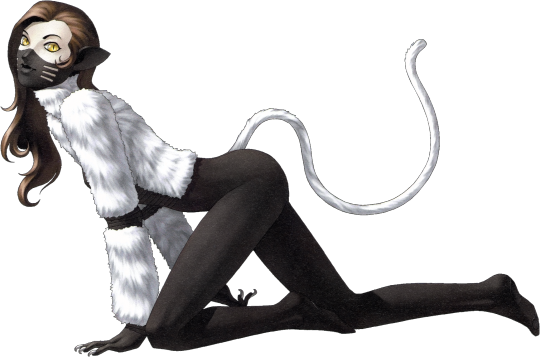
Race: Beast
Alignment: Neutral
April 12th, 2024
Ferocious felines are a commonplace story in fiction- Whether it be the Matagot of French fairytale, the Wampus cat from Cherokee myth, or the Cat-Síth of Scottish folklore, many a cat has become a cornerstone of popular mythology. However, none are as famous, or perhaps infamous, as the yōkai pair, Bakoneko and Nekomata.
Based primarily in the mountainous regions of Japan, though some are domestic, Nekomata are twin-tailed cats that are perceived as ferocious monsters while out in the wilds, yet kind and loving long-living pets when domesticated. Nekomata purportedly had very long shelf-lives, so to speak, typically growing very old, and as each year goes on, their tail would grow in length. This is actually due to a reason for why they come to be, as it was commonly believed that, when a normal cat grew old enough, its tail would split, and it would become a Nekomata. As Arai Hakuseki put it, "Old cats become 'nekomata' and bewilder people."
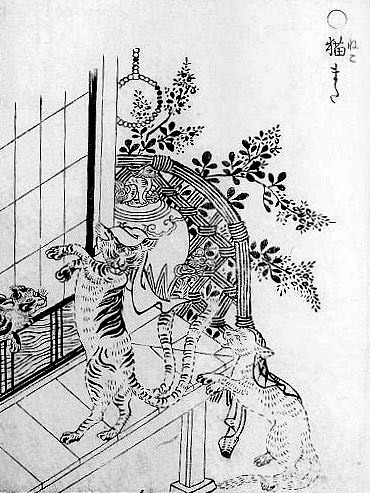
This is a borrowed observation from Tony4You, but commonly, people inflicted with a so-called Nekomata disease from the mountainous variety of these mystical cats likely began to suffer from rabies instead, and the erratic, almost unnatural behavior of the cats within the mountains was likely as a result of them being rabid as well. Nekomata likely had a very real and natural explanation, as unfortunate as rabies can be.
In terms of the SMT series, Nekomata is a very common early-game demon, typically specializing in physical and force skills. This likely is related to the commonplace depictions of Nekomata lashing out physically within the mountains, as well as their wise ways possibly giving way to an understanding of magic. The depiction in the series is rather faithful visually, with my personal favorite version being far more unique with a humanoid shape and brown, long hair, alongside a furry coat and black tights. It looks like something that I would personally wear, honestly. My main question with the design is, where are the two tails? The double tails are the main thing separating Nekomata from Bakeneko, yet they appear absent in the SMT design.
Despite that, Nekomata are a rather strange bit of folklore with a very real explanation, and they have one of the most iconic and cute designs in the series, earning a favorite spot from me.
#shin megami tensei#smt#megaten#persona#daily#nekomata#japanese yokai#i love this thing#the gato#also#back to our regularly scheduled programming
13 notes
·
View notes